
Wood Lane Hall is a Grade I listed building near Sowerby, West Yorkshire, England. [1]

Wood Lane Hall is a Grade I listed building near Sowerby, West Yorkshire, England. [1]
The original hall had a timber frame, [1] parts of which were retained when it was rebuilt in the mid-1650s as a prodigy house for yeoman clothier John Dearden. The new building was constructed to an F-shaped floor plan in coursed squared stone with a stone slate roof in two storeys with a cellar and an attic. The frontage has 3 bays of which the outer two are gabled. Over the doorway is the date 1649 and the letters JDED for John and Elizabeth Dearden. Noticeable features are the rose window, embattled parapets and elaborate finials.
The hall remained in the Dearden family for several generations until it was divided into three dwellings in the early twentieth century, with the main hall boarded over to provide extra accommodation upstairs. In 1949 the house was purchased by the Sugden family, owners of a brass foundry in Halifax, who restored the building to its previous condition, opening up the main hall and replacing the panelling, the balustrade, the minstrel gallery and other original features. [2]

Lyme Park is a large estate located south of Disley, Cheshire. The estate is managed by the National Trust and consists of a mansion house surrounded by formal gardens, in a deer park in the Peak District National Park. The house is the largest in Cheshire, and is recorded in the National Heritage List for England as a designated Grade I listed building.

Oakworth Hall is located in Oakworth, West Yorkshire, England. The manor house was rebuilt in the 17th century, but has a history dating back to 1066. The building overlooks the Worth Valley, facing south towards Haworth.
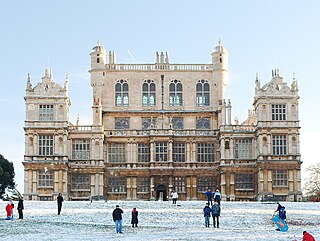
Wollaton Hall is an Elizabethan country house of the 1580s standing on a small but prominent hill in Wollaton Park, Nottingham, England. The house is now Nottingham Natural History Museum, with Nottingham Industrial Museum in the outbuildings. The surrounding parkland has a herd of deer, and is regularly used for large-scale outdoor events such as rock concerts, sporting events and festivals.

Carbrook Hall is a historic house in Sheffield, England. Located in the Carbrook district of the city, the original building was owned by the Blunt family from 1176. This was rebuilt in 1462, and was bought by Thomas Bright in the late 16th century. His descendant, John Bright, was an active Parliamentarian during the English Civil War, and the building was used as a Roundhead meeting place during the siege of Sheffield Castle. Most of the building was demolished in the 19th century, what survives is a Grade II listed stone wing that was added c. 1620. It is currently occupied by Starbucks having previously been used as a public house. Planning permission was granted in November 2018 to turn the building into a Starbucks drive-thru and coffeehouse. In 2019 Starbucks opened a Drive Through Coffee House which maintains all the original features including the plaster mouldings and wood panelling. It is reputed to be haunted with the sounds of children and babies crying and a number of doors opening on their own.
Harewood Castle is a 14th-century stone hall house and courtyard fortress, located on the Harewood Estate, Harewood, in West Yorkshire, England. Harewood Castle is a grade I listed building.
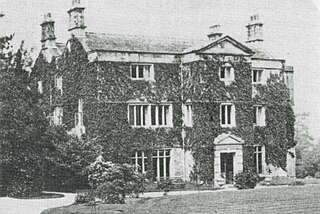
Whiteley Wood Hall was an English country house which was demolished in 1959. It stood off Common Lane in the Fulwood area of Sheffield, England. The hall’s stables and associated buildings are still standing and along with the surrounding grounds now serve as an outdoor activities centre for Girlguiding Sheffield. The stables are a Grade II listed building.
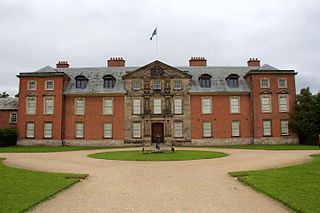
Dunham Massey Hall, usually known simply as Dunham Massey, is an English country house in the parish of Dunham Massey in the district of Trafford, near Altrincham, Greater Manchester. It is now a National Trust property, open to the public. During World War I it was the Stamford Military Hospital.

Fair House Farmhouse is a 17th-century building situated on Annet Lane in the village of Low Bradfield within the boundary of the City of Sheffield in South Yorkshire, England. The farmhouse is a Grade II* Listed Building while the stable and garage buildings immediately to the west of the main house are Grade II listed..

Onesacre Hall is a Grade II* Listed building situated in the rural outskirts of the City of Sheffield in South Yorkshire, England. The hall is located on Green Lane in the small hamlet of Onesacre in the suburb of Oughtibridge, 5 miles (8.5 km) north west of the city centre.

Tapton Hall is a Grade II listed building situated on Shore Lane in the Crosspool area of Sheffield, England.
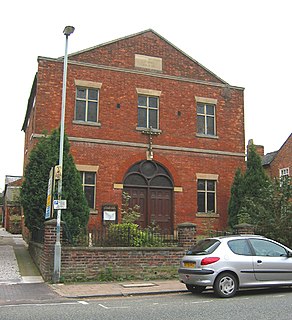
The Primitive Methodist Chapel is a former Primitive Methodist church on Welsh Row in Nantwich, Cheshire, England. Built in 1840, it is listed at grade II. The chapel closed in 2001, and the building has been partially converted to residential use.

Mount Pleasant is an 18th-century mansion situated on Sharrow Lane in the Highfield area of the City of Sheffield in South Yorkshire, England. The house stands just under two km south of the city centre and is a grade II* listed building, it has been described as "one of the best 18th century houses in Sheffield". The adjacent former stables and coach house are also Grade II* listed.

Hulme Hall is a house on a moated site in the parish of Allostock, Cheshire, England. It originated in the 15th century, with additions and alterations in the 17th and 19th centuries. It is now a farmhouse. The house is constructed in brown brick, and has a roof of stone-slate and Welsh slate. It is in two storeys with an attic, and has an asymmetrical plan. The northeast front is the entrance front, and has three gabled bays. The garden front is on the northwest; it has five bays, two of which are stepped back in two stages. Most of the windows are two or three-light casements. The house is recorded in the National Heritage List for England as a designated Grade II* listed building. The bridge over the moat leading to the house is also listed at Grade II*. The moated site on which the house stands is a scheduled monument. It had been the home of the Grosvenor and Shakerley families, both of whom were prominent in Cheshire.

Oakes Park is a privately owned, historic park land in the green-belt area of south Sheffield. It contains 15 private homes as well as a 17th-century English country house which now operates as The Oakes Holiday Centre, a Christian, residential activity centre for young people between the ages of 8 and 18. It is set in extensive grounds which make it very difficult to be seen by the general public. It is situated on Norton Lane in the suburb of Norton within the City of Sheffield in England. The house is a Grade II* listed building, as are several other buildings and features.

Stumperlowe Hall is a small English country house situated in the City of Sheffield, England. It is located on Stumperlowe Hall Road at its junction with Slayleigh Lane in the suburb of Fulwood. The hall is a Grade II listed building.

Fulwood Hall, is an English country house situated on Harrison Lane in the suburb of Fulwood in Sheffield, England. It is a Grade II listed building. The hall stands in a lofty position on the north side of the Mayfield Valley at a height of 270 metres. The hall is referred to as Fullwood Hall on old maps and the gate to the hall uses this spelling with two Ls.
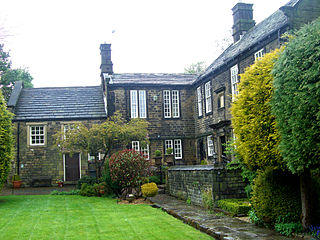
Birley Old Hall is a small English country house situated in the Birley Edge area of the City of Sheffield, England. The hall stands in an exposed situation at almost 200 metres above sea level on Edge Lane, some six km NW of the city centre and has been designated a Grade II listed building by English Heritage as has the Falconry which stands in the garden.

Heathcote is a Neoclassical style villa in Ilkley, West Yorkshire, England. Designed by architect Edwin Lutyens, it was his first comprehensive use of that style, making it the precursor of his later public buildings in Edwardian Baroque style and those of New Delhi. It was completed in 1908.

Royds Hall Manor is one of the surviving manor houses in the Yorkshire Region. It is a Grade II* listed building situated on an elevation over 700 feet above sea level in Bradford, West Yorkshire, England and was once the residence of the Lords of the Manor of North Bierley and Wibsey.

The Elinor Lupton Centre is a Grade II listed former Church of Christ, Scientist, and former school building located in the Headingley area of Leeds, West Yorkshire, England. It was designed by Piet de Jong and William Peel Schofield from the architectural firm Schofield and Berry. Constructed in white Portland stone in a mixed style of Egyptian Revival and Art Deco, it was originally built as a Sunday school in c.1912–1914, extended in the 1930s with a church building and then used by the Leeds Girls' High School as a theatre and music centre from 1986 until 2010. The structure has architectural significance in the locality due to its distinct style and use of materials; many original features and fittings survive, including the entrance foyer, two staircases and a glazed lantern in the auditorium roof.
Coordinates: 53°42′33″N1°56′09″W / 53.7093°N 1.9358°W
| | This England-related article is a stub. You can help Wikipedia by expanding it. |